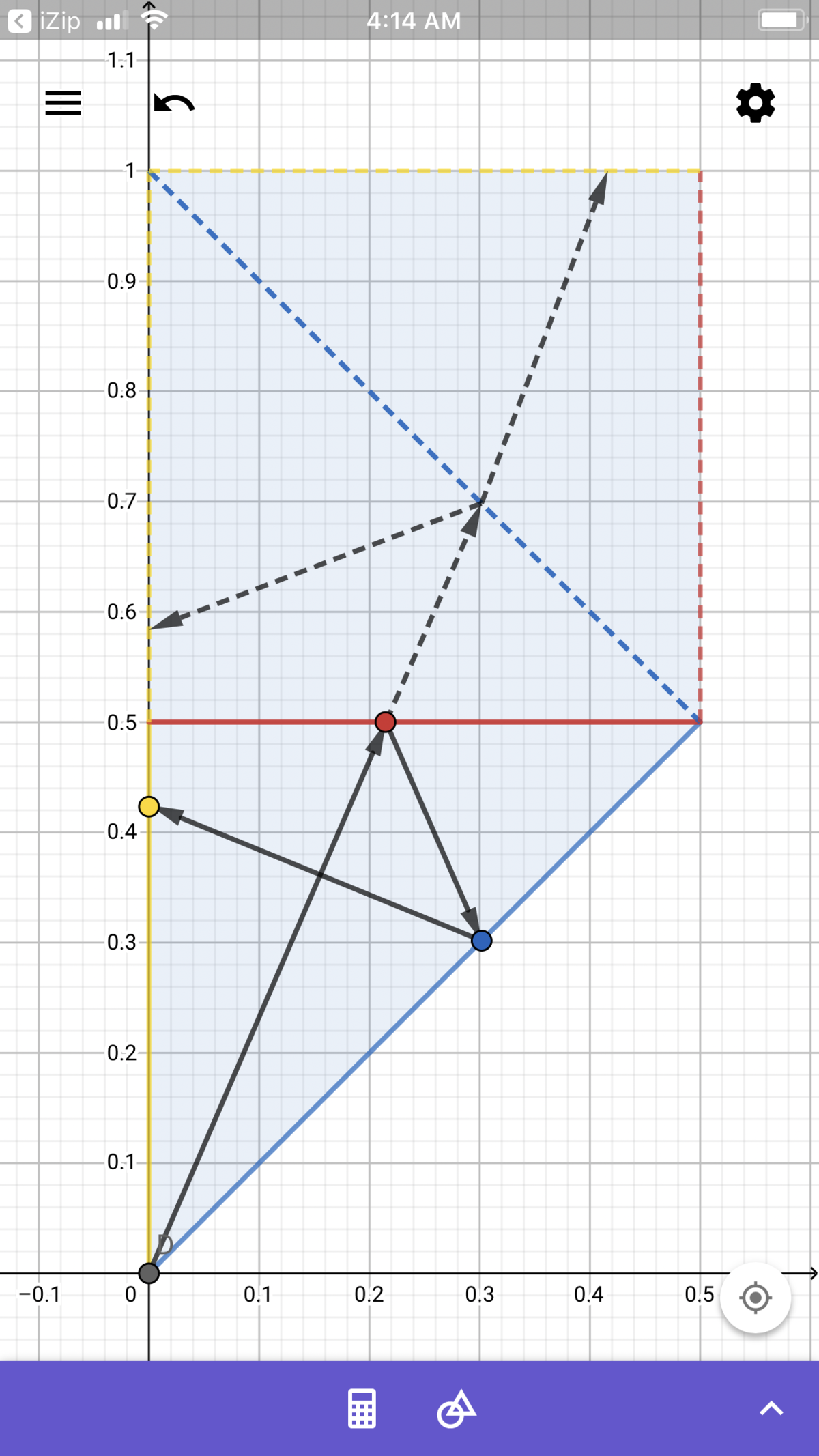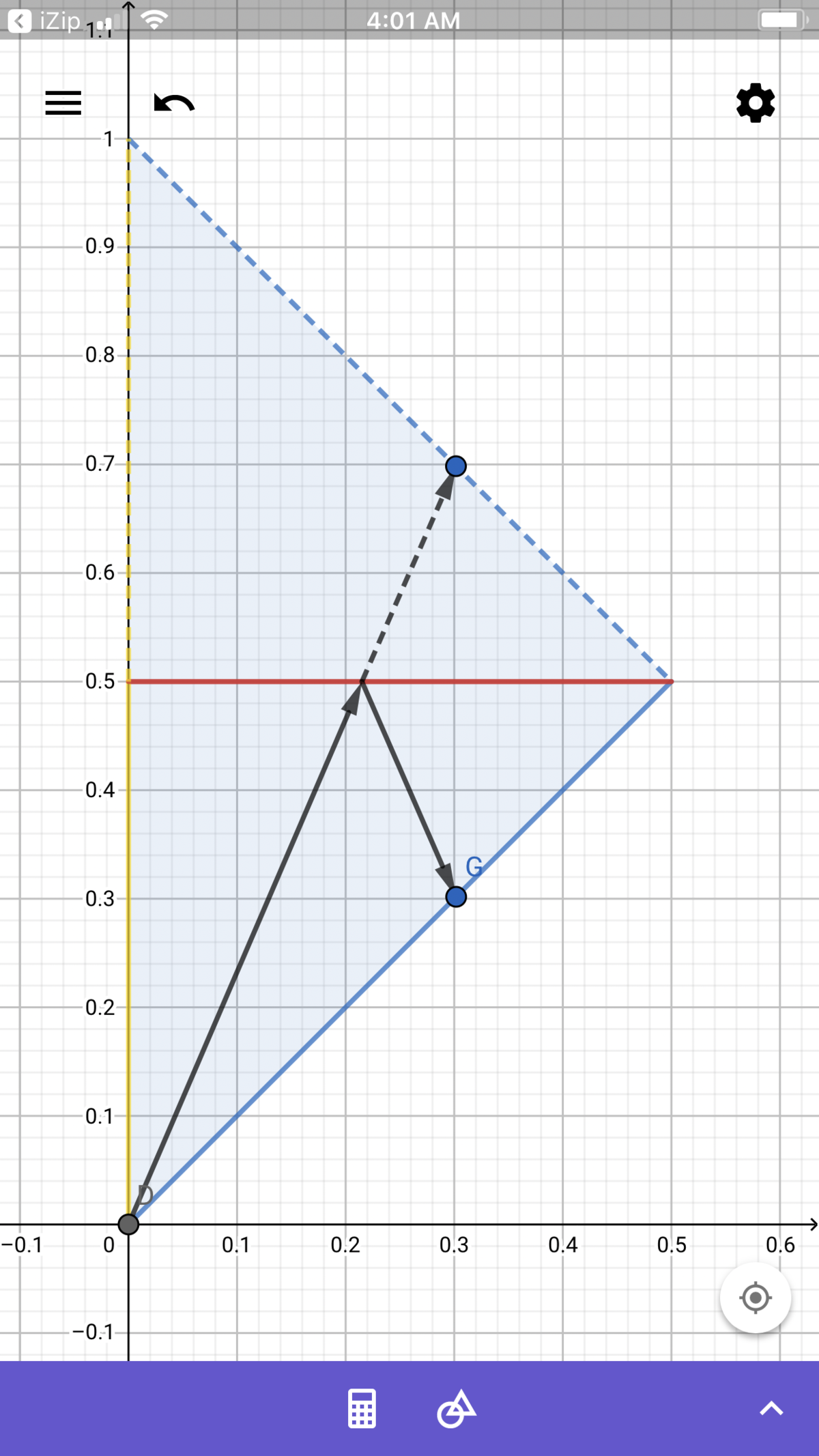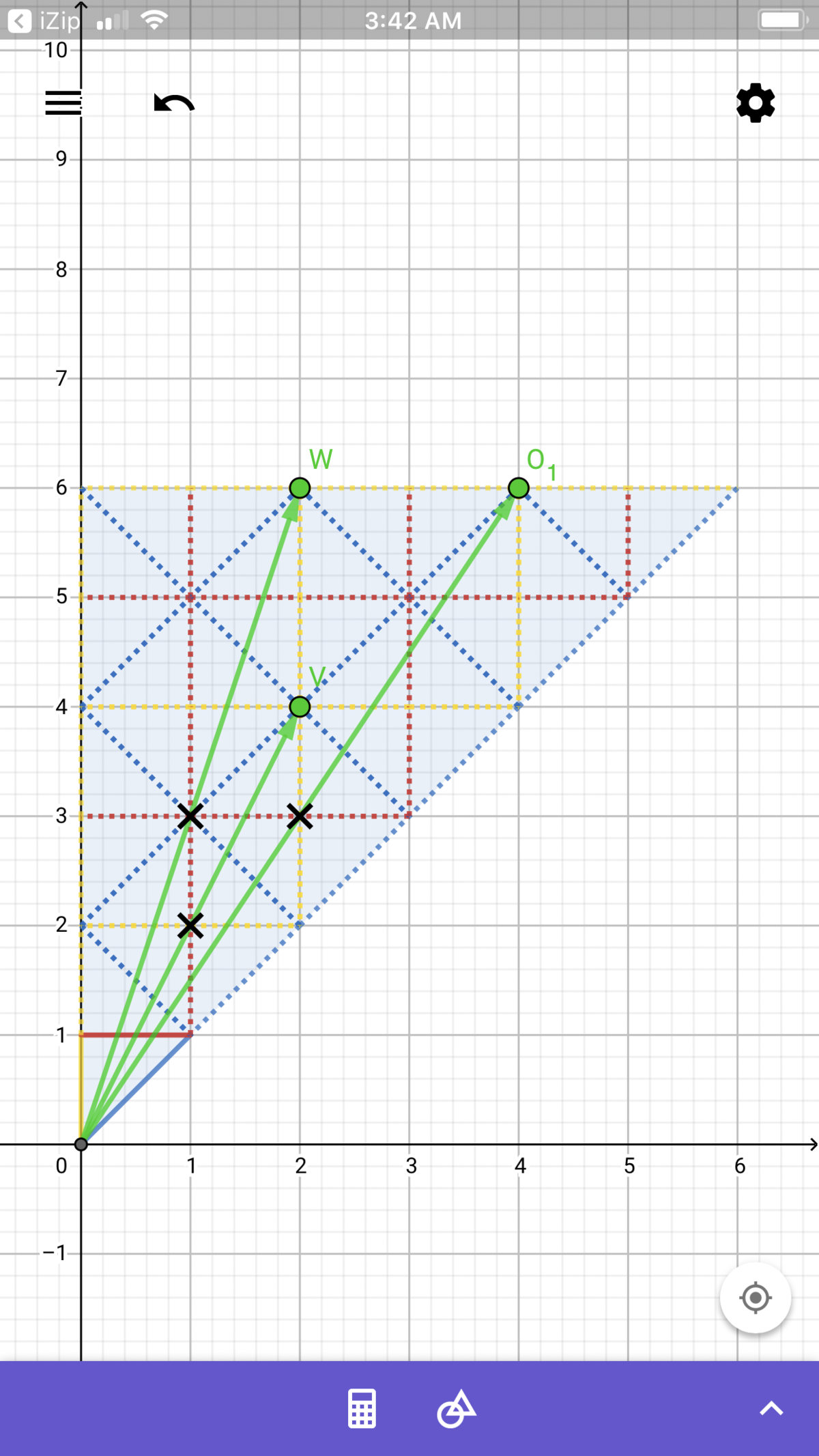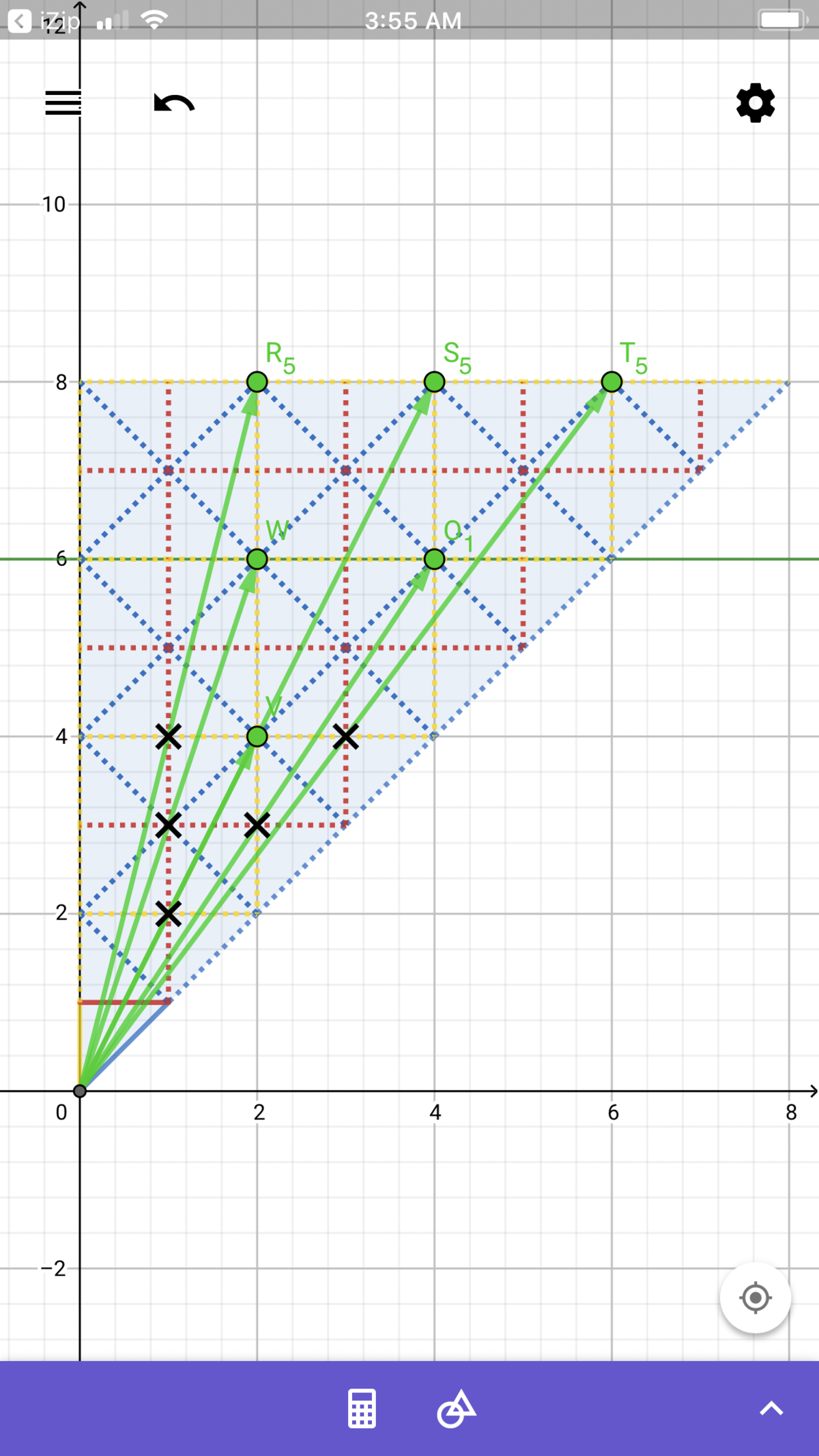Triangular Pool Bounce
Suppose you have a triangular pool table with a ball starting at the marked vertex of the billiard table shown (shaped like an isosceles right triangle). Is it possible to hit a ball that reflects back to where it started (given any number of reflections)?
Assume geometric purity: the "ball" has no mass and the "ball" and "hole" are considered single points. Also, if the ball hits a vertex point as opposed to a side, then the reflections are absorbed. (This means hitting straight up towards the right angle won't work.)
This problem is part of the Brilliant.org Open Problems Group . The end goal for each open problem is to find a solution, and maybe publish it if it's a nice enough result! You can read about the unsolved billiards problem that this one is related to here .
This section requires Javascript.
You are seeing this because something didn't load right. We suggest you, (a) try
refreshing the page, (b) enabling javascript if it is disabled on your browser and,
finally, (c)
loading the
non-javascript version of this page
. We're sorry about the hassle.
8 solutions
This is a genius explanation. Props to you, sir!
Brilliant.org :)
at u guys finished praising some person.Praise me i know the answer.im too savage so the answer is pi divided itself times 2 squared so it is impossible to hit the ball.SO NOW PRAISE ME
Log in to reply
All hail Suhaas
I think you're lost.
Congrats :)
are not at
This problem is incorrect. Hit the ball straight along the left side and angle of incidence equaling angle of reflection, it will return back down that side. Of course then I read their cheat caveat which eliminates the actual way to do it. Cheaters!
Log in to reply
If a reflecting object hits an actual vertex, there is no reflection. Reflections happen off a side. (What's confusing here is the real physical situation feels like you can do that - but the ball is reflecting on the side adjacent to the vertex, not the vertex itself.)
i only read half the problem, got it wrong :/
Of course in reality you apply bias to the ball (side spin) and then it will reflect back along the same line
Log in to reply
As mentioned in the problem, we are assuming "geometric purity" so the ball has no mass.
Don't worry, billiards fans, we have a science problem coming up next week.
Probably helps to add in the rules that the "absorption" which occurs are the corners removes the ball from the table, rather than absorbing the reflections which is rather ambiguous.
Simpler to say that the corners are "pockets" just like a billiard table.
Solid explanation. I think it's the only way to solve these irregular pool table problems.
Log in to reply
Thanks! I believe the strange wording is to set things up for a deeper problem found here .
nicely explained
We can think of the table borders as mirrors and the ball trajectory as the light. Then we project the everything that's in front of the border to behind the border.



 If we do this process of reflecting over and over and follow a straight line from the origin, we can start to see when the ball would hit the origin point. The origin point on this case is just where the yellow and blues lines meet. So we just follow the ball trajectory.
We have points in the border wall itself, but we can't hit these because the rules don't allow (it is the same as throwing the ball parallel to the border).
So we have left the green points in the picture. But notice that in order to hit them, we always pass through a encounter of two lines (the black 'x' in the pictures). But we can't do that too because it's the same as hitting a vertex!
If we do this process of reflecting over and over and follow a straight line from the origin, we can start to see when the ball would hit the origin point. The origin point on this case is just where the yellow and blues lines meet. So we just follow the ball trajectory.
We have points in the border wall itself, but we can't hit these because the rules don't allow (it is the same as throwing the ball parallel to the border).
So we have left the green points in the picture. But notice that in order to hit them, we always pass through a encounter of two lines (the black 'x' in the pictures). But we can't do that too because it's the same as hitting a vertex!

 This is actually just a way to visualize a geometric pattern that will repeat itself if we expand the representation many times more. It's no hard proof.
But it's a precise representation of the trajectory, and from it we can try to work on a prove. It would probably involve writing the functions of all the lines in the form of y=mx+b; and finding where they cross each other (y=y). Then we show that every vector connecting the origin to the points where the yellow and blue lines meet (the return point) always passes
through a vertex first.
I didn't have the time now to try to formalize a proof but I think this visualization might be useful.
This is actually just a way to visualize a geometric pattern that will repeat itself if we expand the representation many times more. It's no hard proof.
But it's a precise representation of the trajectory, and from it we can try to work on a prove. It would probably involve writing the functions of all the lines in the form of y=mx+b; and finding where they cross each other (y=y). Then we show that every vector connecting the origin to the points where the yellow and blue lines meet (the return point) always passes
through a vertex first.
I didn't have the time now to try to formalize a proof but I think this visualization might be useful.
I was also working on a very similar solution, and I found a way to prove all vectors to the green points must pass through another vertex.
Look at the coordinates of the green points. (2,4), (2,6), (2,8), (4,6), (4,8) and (6,8). Both the X and Y coordinates are always even. So every green point can be written in the form (2a, 2b) where a and b are positive integers, and b > a. To reach the point (2a, 2b) it's required to go through the point (a, b), which is a vertex.
Regarding a deleted comment - please be respectful of the solutions people post. They can be whatever length that helps themselves and other people understand the problem.
Let the initial velocity vector be ( u , v ) . In order for the ball's motion to be inside the triangle, necessarily 0 < u < v .
The left, top and hypotenuse cushions give the velocity mappings ( x , y ) → ( − x , y ) , ( x , y ) → ( x , − y ) and ( x , y ) → ( y , x ) respectively. Thus the only possible velocities at a given time are ( u , v ) , ( − u , v ) , ( u , − v ) , ( − u , − v ) , ( v , u ) , ( − v , u ) , ( v , − u ) and ( − v , − u ) . Of these, only ( − u , − v ) is possible when the ball is returning to the vertex it started at.
As such, in order to return to the vertex the ball must travel back along its path. Since the physics are invariant under time reversal, the second half of the journey will be the time reversal of the first half. As such, at the halfway point the ball would have to reverse direction instantaneously.
However, this is impossible:
- To reverse direction by bouncing off the left cushion would require y = 0 . Since 0 < u < v , no such velocity is reachable.
- To reverse direction by bouncing off the top cushion would require x = 0 . Since 0 < u < v , no such velocity is reachable.
- To reverse direction by bouncing off the hypotenuse cushion would require x = − y . This would have to come from one of the velocities where the components have opposite signs. But at a given time, ∣ x ∣ = u and ∣ y ∣ = v or vice versa, so we would require u = v , which we know isn't the case.
Oh wow! I think this is the simplest solution here. Thank you for sharing man!
shorter solution, but for me its harder than others
I think one thing is missing from this proof - that the ball cannot hit a wall at 90 degrees, because if it does so, it will indeed reverse direction instantaneously.
doesnt make any sense to me ..ev1 knows.. to come back to origin, later half of the journey will be the reverse of earlier half . why are you saying "at the halfway point the ball would have to reverse direction "instantaneously", which is impossible" plz explain.. because for any other triangle say (60,90,30) ball would reverse its direction at hypotenuse if sent from 60 degree vertex at 30 degree with the hypotenuse..!! :-(
Log in to reply
I've now added some detail to cover this.
Log in to reply
Good solution! Suggest changing your language to make it more clear. Instead of "reversing direction instantaneously", "the ball has to hit the wall perpendicularly" or mentioning 90 degree would be better.
now its clear...
Just draw the picture, assume a direction firstly, then you can draw each point where the ball changes its direction according to the pattern of reflection. Once you have done that for four times, you can find out that the direction of the third reflection parallel to the first direction you assume. And now, you are very close to the final answer, because what you should do now is only to regard each three reflection as a circulation. And the only difference beteewn two circulation is the length of the ball's routine, all the directions in each circulation are same. So the just go deeper and deeper into the right angle but will never achieve it.
Let's call a the clockwise angle between the y axis and the current trajectory, then
l ( a ) = − a mapping of the left mirror
t ( a ) = 1 8 0 ° − a mapping of the top mirror
d ( a ) = 9 0 ° − a mapping of the diagonal mirror
So the initial angle a 0 is only changed by compounding the above transformation into a few possible angles.
The trajectory cannot retrace itself back to the origin because a = 0 ° a n d 4 5 ° are not admitted for a 0 , so multiples of 45° will never be reached compounding the transformations, so the transformations above will never behave as a retracement f ( a ) = a + 1 8 0 °
The alternative is a trajectory that doesn't retrace itself but eventually ends up at the origin. This is absurd thought because will require a final angle a ∗ = 1 8 0 + a 0 given the finite options of the compound transformations, but this will mean retracing the first segment.
You gotta Have a nice reasoning to solve it At any number of step ,(considering that the ball returns to the original position) the coordinates must change (x,y) |------>(y,x) for an odd number of times considering the two sides two be the x and y axes we see that such change is never possible(even once).
I don't see the holes, so i assumed one in the middle. Bounce a ball straight at a band. Both will give solutions.
No matter how many times the triangle is folded, the ball always passes from one vertex of the big triangle to the other vertex, and the ball cannot move along the edge, so this is impossible.
If the ball is struck so it travels along the adjacent side (i.e. toward 12 0'clock) it will rebound from the opposite adjacent side back to its starting position! -Charles1
If the ball is located at the vertex (located where 2 edges meet), why can't the ball travel along the edge?
Let us consider a light ray instead of the ball and the angle of release (angle made with the perpendicular of ∆) as ø. After 1st reflection, the angle made by the reflected ray with the Hypotenuse would be (3π/4-ø). For the ray to retrace it's path, this angle should be equal to π/2 which isn't possible (as ø cannot be equal to π/4). Therefore, the ball will never get back to it's starting pt.
We can visualize the ball travelling in a straight line through a series of reflected isosceles right triangle pool tables with legs that are 1 unit long, and place the result on a coordinate grid, as shown below:
Then the goal would be to draw a straight segment from ( 0 , 0 ) to one of the red points without going through a blue point. However, since all of the red points are on points in which both coordinates are even, its x : y ratio can be simplified by a greatest common power of 2 factor to give new point with the same x : y ratio where at least one coordinate is odd (a blue point). In other words, it is not possible to draw a straight segment from ( 0 , 0 ) to one of the red points without going through at least one blue point. Therefore, it is not possible to hit a ball that reflects back to where it started.